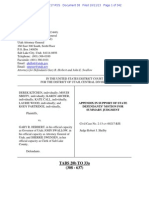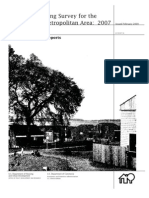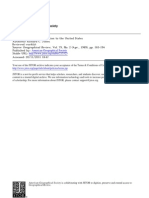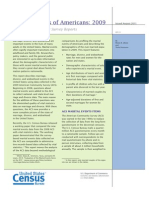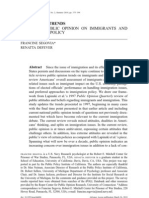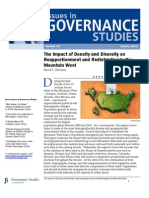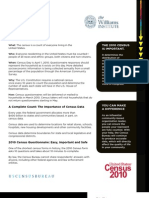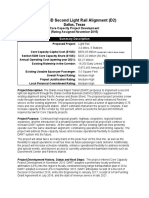Beveridge Report
Beveridge Report
Uploaded by
SchutzeCopyright:
Available Formats
Beveridge Report
Beveridge Report
Uploaded by
SchutzeCopyright
Available Formats
Share this document
Did you find this document useful?
Is this content inappropriate?
Copyright:
Available Formats
Beveridge Report
Beveridge Report
Uploaded by
SchutzeCopyright:
Available Formats
PRELIMINARY EXPERT REPORT OF ANDREW A. BEVERIDGE, PH.D.
Submitted in UNITED STATES ex rel. CURTIS LOCKEY and CRAIG MacKENZIE v. CITY OF DALLAS, TEXAS, et al., Case No. 3:11-cv-00354-O (N.D. TEXAS)
1)
I am a Professor of Sociology at Queens College and the Graduate Center,
City University of New York. My primary responsibilities at the College and Graduate Center are teaching statistics and research methods at the graduate and undergraduate level and conducting quantitative, statistically-based social research. In July 2006, I assumed a three-year term as chair of the department and began a second term in July 2009. Trained at Yale University, I have been a professor since 1973, first at Columbia University until 1981 and since then at Queens College and the Graduate Center of CUNY. My areas of expertise include demography, the statistical and quantitative analysis of social science datasets, most particularly including Census data, survey data and administrative records. I am an expert in the application of Geographical Information Systems (GIS) technology to the analysis of social patterns. I regularly publish results in professional journals and peer reviewed books. Some of my analyses have served as the basis for articles in the New York Times, where I serve as a demographic consultant through an agreement between Social Explorer, Inc., the CUNY Research Foundation and the Times. I have served as a consultant to a number of public and private entities, where I provide services related to demographic analysis. 2) I have testified as an expert in demographic and statistical analysis, including
affidavit testimony and the submission of reports in a number of cases, including but not limited to: Favors v. Cuomo, et al., U.S. District Court for the Eastern District of NY (Hearing Testimony, 2012); MSP Real Estate, Inc., et al., v. City of New Berlin, et al., and United States v. City of New Berlin, U.S. District Court for the Eastern District of Wisconsin; (Report, 2011) Bear Development LLC v. City of Kenosha and Redevelopment Authority of the City of Kenosha, U.S. District Court for the Eastern District of Wisconsin (Report and Deposition Testimony,
2011); Melvin Boone, et al., vs. Nassau County Board of Legislators, et al. U.S. District Court for the Eastern District of New York. (Report and Trial Testimony, 2011); Adriana Aguilar, et al., v. Immigration and Customs Enforcement, Division of the United States Department of Homeland Security, et al. U.S. District Court for the Southern District of New York. (Report, Rebuttal Report and Deposition Testimony, 2010); Commonwealth of Virginia v. Prieto, Fairfax City Virginia Circuit Court (Affidavit and Trial Testimony, 2010); State of Georgia v. Jason McGhee, Forsyth City Georgia State Court (Trial Testimony, 2010); Isidoro Rivera, et al. v. Incorporated Village of Farmingdale, et al, U.S. District Court for the Eastern District of New York (Report 2009); Fair Housing in Huntington Committee, et al. v. Town of Huntington, New York, et al, U.S. District Court for the Eastern District of New York (Report and Rebuttal Report, 2010). Barkley v. United Homes LLC. et al., U.S. District Court for the Eastern District of New York (Report, Deposition and Trial Testimony, 2009-2011); Mount Holly Gardens Citizens in Action, Inc., et al v. Township of Mt. Holly, et al. U.S. District Court for the District of New Jersey (Declaration, 2008 and 2010); Antidiscrimination Center of Metropolitan New York v. County of Westchester, et al., U.S. District Court for the Southern District of New York (Report, Rebuttal Report and Deposition Testimony, 2008-2009); Five Borough Bicycle Club, et al v. City of New York, et al. U.S. District Court for the Southern District of New York Report (Deposition and Trial Testimony, 2008-2009); Vargas, et al. v. Town of Smithtown. U.S. District Court for the Eastern District of Long Island (Report, 2008); Helene Henry, et al v. National Housing Partnership, United States District Court, Northern District of Florida, Gainesville, Division (Three Reports and Deposition Testimony, 2007-2008); Commonwealth of Virginia v. Sanchez, Prince William City Virginia Circuit Court (Affidavit, 2008); Commonwealth of Virginia v. Ajlan, Prince William City Virginia Circuit Court (Affidavit, 2008); New Hampshire v. Addison,
Hillsborough City, New Hampshire, North Division, Superior Court (Declaration, Deposition and Testimony, 2008); U.S. vs. Port Chester, Southern District of New York (Report, Two Declarations, Deposition and Hearing Testimony, 2002-2009); Anderson, et al. v. Jackson, et al. U.S. District Court for the Eastern District of Louisiana (Report and Deposition, 2007); Martinez v. Kelly, United States Court of Appeals for the Second Circuit (Declaration Regarding Peremptory Jury Strikes, 2006); Commonwealth of Virginia vs. Portillo-Chicas, Stafford City Virginia Circuit Court (Affidavit, 2006); Commonwealth of Virginia vs. Rogers, Stafford City Virginia Circuit Court (Report and Testimony, 2006); U.S. v. Margaret Torres, Eastern District of Louisiana (Declaration, 2006); U.S. v. Caldwell, Eastern District of Louisiana (Declaration 2006); U.S. vs. Darryl Green, et al. Eastern Division of the District of Massachusetts (Seven Declarations and Trial Testimony 2004-2006), A more complete list of cases and other matters in which I have provided opinions are listed in my rsum, attached as Exhibit A. 3) I was retained Michael Allen of Relman, Dane & Colfax, PLLC, who is
representing Curtis Lockey and Craig MacKenzie. I was asked to review Dallas Texass approach to addressing potential race based impediments to fair housing, including assessing the 2007-2012 Analysis of Impediments (A Five Year Action Plan). Commonly called an AI. I was asked to conduct my review from my perspective as an expert in the analysis of demographic and statistical patterns. 4) 5) I am charging $275 per hour plus all expenses for this work. To receive Community Development Block Grant Funds Dallas Texas must
perform an analysis of the impediments to fair housing; take action to overcome those impediments; and maintain records concerning the impediments found and the actions to overcome them by affirmatively furthering fair housing.
6) assessment:
I had access to the following material when conducting my own analyses and
a. Data produced by the United States Bureau of the Census for 2000 and 2010 were used from the PL94-171 file (the redistricting file) and the Summary File 1 (both of which are based upon the so-called short form data, which has data about race, Hispanic status, age, sex, household relationship, and ownership status of the dwelling unit.) b. Data produced by the Census Bureau for the 2006-2010 American Community Survey, which is a large ongoing survey that has replaced the so-called Census long form. These data include information about housing, economic status and race. These data are tabulated and reported at a variety of geographic levels, from nationwide all the way down to Census tracts and block groups. . c. SAS, a widely used data management, analysis and reporting computer program was used, along with Microsoft EXCEL, a standard spread sheet package. d. The complaint in this case. e. A Geographic Information System (GIS), Maptitude, with Census boundary files for Census 2000 and 2010, as well as other mapping data. f. Data from the report Picture of Subsidized Households, 2008, published by the US Department of Housing and Urban Development, Office of Policy Development and Research. (Available from www.huduser.org.)
g. A variety of documents from Dallas Texas, including the Consolidated Plan for 2004 to 2008; The Analysis of Impediments for 1998 and 2007; various Annual Action Plans, the Consolidated Plans for 2003-2004 2007-2008 and 2008-20092012-2013; a report from the Mayors Taskforce on Workforce Housing, 2002; and various other documents as cited. A. DALLAS TEXAS ANALYSIS OF IMPEDIMENTS NOTES BUT DOES NOT MEASURE OR ANALYZE THE HIGH LEVEL OF RACIAL SEGREGATION IN THE CITY, EVEN THOUGH THE DATA NECESSARY FOR SUCH AN ANALYSIS ARE SHOWN AS TABLES AND PRESENTED, AND THE METHODS FOR SUCH AN ANALYSIS ARE WELL KNOWN 7) The 2007 Analysis of Impediments consists of 192 pages of text, tables and
map, including pages of data that could have easily been used to assess the level of segregation in Dallas. Instead, the following three paragraphs present all of the analysis regarding segregation in the report:
Degrees of Segregation by Race and Ethnicity As of 2000, the percentage of minority households have increased from 50 percent to 61.2 percent of Dallas' households; consisting of 35.6 percent Hispanic and 25.6 percent African American compared to 1990 percentages of 21 percent and 29 percent, respectively. The minority households in Dallas remain concentrated in the Northwest, Southwest and Southeast sub-areas of the city. Race and ethnic distribution is illustrated in Maps 1-2 and 13. Map 1-2 shows that the higher concentration (50 percent or greater) of African American households continues to populate the lower Southwest and western section of the Southeast subareas of Dallas. However, the 2000 Census data shows a slight shift in the location of African American households resulting in a decrease in African American households residing in the Southeast area and an increase in the eastern borders of the Southeast and Northeast sub-areas of Dallas. Census tract 115, in the Southeast area of Dallas, decreased in African American population from greater than 80 percent in 1990 to 50 - 75 percent in 2000. However, the African American population in Census tracts 120, 121,122.07 and 176.03, on the eastern border of the Southeast area of Dallas increased from 20 to 40 percent in 1990 to 50-75 percent in 2000 and increased in the eastern bordering Census tracts of the Northeast sub-area of Dallas from less than 20 percent in 1990 to 25-50
percent in 2000. Map 1-3 shows that Hispanic households continue to primarily populate the Northwest and Southwest sub-area of Dallas. However, the population of Hispanic households in the Southeast sub-area significantly increased from 20-40 percent in 1990 to 25-50 percent in 2000, in the middle section of the Southwest sub-area from 20-40 percent in 1990 to 5075 percent in 2000, and in Census tract 166.05 from 20-40 percent in 1990 to 50-75 percent in 2000. White households are primarily in the Northeast and North central subareas of Dallas. 8) Nowhere in these 192 pages is the subject of race and Hispanic status assessed
as a potential impediment to fair housing. 9) Dallas Texas presents the tools to make such an assessment in its AI. The
series of maps and tables presented in the AI include all the information would be required for such an analysis. For instance, maps showing the concentration of the population by black and Hispanic status are presented in the AI. They are reproduced here as Exhibits B and C. Furthermore, the data that makes segregation analysis possible is presented in tabular form in the AI. 10) Maps showing the distribution of the non-Hispanic black, the Hispanic
population and the combined non-Hispanic black and Hispanic population are the natural starting point for assessing impediments to fair housing. For instance, if the non-Hispanic black population is heavily concentrated in specific areas, it suggests that barriers to fair housing may exist. 11) Using readily available Census data and Census boundaries, which are similar
to those in the AI, I have prepared simple maps of the concentration of non-Hispanic black population, the Hispanic population and the combined Hispanic and non-Hispanic Black population within Dallas Texas, which are presented as Exhibits D, E, and F. Unlike the Citys maps, these maps are done at the Census block level, which represents more precise mapping.
12)
It is plain from a cursory examination of these maps that Dallas Texass non-
Hispanic black population, Hispanic population and non-Hispanic black and Hispanic population taken together are each highly concentrated. The Citys maps shows the same pattern, but with less detail at the Census tract level. 13) This fact was known to Dallas Texas, since it was presented in its AI. Despite
this, only a passing mention of the pattern of segregation of the African American and Hispanic population appears in the Analysis of Impediments. 14) The pattern of spatial concentration of the African American and Hispanic
population in my map and the Citys map show that Dallas Texas is segregated with respect to race and Hispanic status: that is, black and Hispanic residents tend to live apart from white residents. 15) Once it was obvious that a pattern of segregation existed, the City needed to
measure it, and then to begin to understand its genesis and how it is perpetuated. It means that there are areas within Dallas where very few African-Americans and Hispanics live and other areas where there is a high concentration of African-Americans and Hispanics. Simply put, high levels of segregation imply that there are barriers to fair housing. 16) The fundamental index of segregation is a measure of how evenly spread out
one group is compared to another group. It is computed based upon the concentration of a group from area to area. For example, suppose a minority group represented 10 percent of the overall population in a given city. If in every single Census block or Census tract, that group made up 10 percent of the population, then one could say that there is no segregation at all (a segregation index of zero). If on the other hand, the entire minority group lived in one set of Census blocks or Census tracts, and every one of those tracts was only inhabited by the minority while all of the
other tracts or blocks were only occupied by the non-minority, then one could say that there is total segregation (a segregation index of 1.0). 17) Racial segregation is always measured by indices that calculate the degree to
which racial separation exists. The most commonly used index of segregation is called the Dissimilarity Index. Technically, it is the proportion of a minority group that would need to move to make the distribution of that group the same over all units. It thus can vary from 0.0, representing no segregation at all, to 1.0, representing total segregation. When computed using the Census block (the unit used in the map in Exhibits D, E and F), the dissimilarity index of non-Hispanic blacks using non-Hispanic whites as the comparison group is .755. This means that 75.5 percent of non-Hispanic blacks would need to move to make them evenly distributed across Dallas with respect to non-Hispanic whites, and achieve no segregation. 18) Similarly, for Hispanics using non-Hispanic whites as the comparison group,
the dissimilarity index is .709, which means that 70.9 percent of the Hispanics would need to be moved to make them even with respect to non-Hispanic whites. 19) When non-Hispanic blacks and Hispanics are considered together compared
to non-Hispanic whites the index is .698. 20) No one, of course, expects segregation to be 0.0 for any group. Generally,
when the dissimilarity index is around 0.30 one can say that low levels of segregation exist. However, in Dallas Texas, we can say that there is a very high level of segregation with respect to non-Hispanic blacks and Hispanics. 21) Other segregation measures are also regularly computed. Here I will use the
Isolation Index which also is a standard and useful measure. It gives the proportion of ones
own group (e.g., non-Hispanic black or non-Hispanic white) that live in the neighborhood (e.g., Census tract or block) that is inhabited by the average member of the group. 22) For isolation, the figures are 0.837 for non-Hispanic whites, 0.811 for non-
Hispanic blacks, and 0.827 for Hispanics. This translates to the following: the average nonHispanic whites neighborhood is 83.7 percent white (considering only non-Hispanic blacks and whites) and the average non-Hispanic blacks neighborhood is 81.1 percent non-Hispanic black, while the average neighborhood for Hispanics with respect to non-Hispanic whites is 82.7 percent Hispanic. This is a relatively high level of segregation and racial separation. 23) In short, the high level of racial segregation in Dallas Texas though mentioned
is not analyzed in the Analysis of Impediments, despite its obvious implications for any analysis of impediments to fair housing, and the availability of the information. B. THE LONGTERM DEVELOPMENT AND INTENSIFICATION OF SEGREGATION IN DALLAS TEXAS IS NOT MENTIONED OR ADDRESSED IN THE ANALYSIS OF IMPEDIMENTS 24) As more African American and Hispanic residents moved to Dallas Texas
from 1980 through 2010, the patterns of racial concentration and racial segregation developed and intensified. 25) Exhibits G, H and I each presents a series of four maps that depict the
changing concentrations of the non-Hispanic black, Hispanic, and combined non-Hispanic black and Hispanic populations in Dallas Texas mapped by Census tract. The data used for these maps and the analyses are readily available from the National Historical Geographic Information System project (www.nhgis.org) and could have easily been used by the City to undertake its own analysis.
26)
It is clear from these maps that the areas that began as somewhat concentrated
with respect to the black population in 1980 became more and more racially concentrated over time, and the size of these segregated areas grew. This is also true for Hispanics and nonHispanic blacks and Hispanics together. 27) When one applies the measures of dissimilarity to the pattern of segregation of
blacks from whites, it is obvious that segregation in Dallas Texas began at a relatively high level, and then increased steadily, or decreased and then rebounded back to a high level. Exhibit J presents a chart that tracks the level of dissimilarity from 1980 to 2000, which was 0.80 in 1980, declined in 1990 and 2000, but increased to 0.76 in 2010. The dissimilarity index for Hispanics increased from 0.55 in 1980 to 0.71 in 2010, and the groups taken together also increased from 0.67 in 1980 to 0.70 2010, after declining in 1990 and 2000. From this chart, one can see that for non-Hispanic blacks, segregation has hardly declined, but for Hispanics it has increased markedly since 1980. 28) Looking at the change in the isolation measure for the same period, it is
obvious that African Americans generally live in tracts with more racial concentration than they did in earlier decades, going from 0.42 to 0.83, while Hispanics went from 0.73 to 0.87. For non-Hispanic whites, there has been a very small lessening of racial concentration or isolation from 0.90 to 0.84. In short, racial isolation is increasing for non-Hispanic blacks and Hispanics, and falling slightly for non-Hispanic whites, but the levels of isolation for all three groups are still very high.
10
C. THE LEVELS OF SEGREGATION WITH RESPECT TO NON-HISPANIC WHITES AND NON-HISPANIC BLACKS IN DALLAS TEXAS ARE NOT SIGNIFICANTLY AFFECTED BY INCOME LEVEL, WHILE THOSE WITH RESPECT TO HISPANICS STILL SHOW HIGH LEVELS OF SEGREGATION EVEN WHEN INCOME IS CONSIDERED 29) The Mission of the Dallas Fair Housing Office is the following: To
affirmatively further and promote fair housing choice through enforcement of applicable local and federal laws and regulations, outreach and education, so that individuals of similar incomes have similar opportunities for housing accommodations, facilities or services without regard to their race, color, religion, sex, national origin, handicap or familial status. (Emphasis added.) 30) To investigate the hypothesis that an income-based analysis could be an
adequate proxy for a race-based analysis in respect to fair housing impediments, I examined whether income segregation in Dallas existed to a degree comparable to racial segregation. I also examined whether affluent African Americans, by virtue of their income, were integrated with affluent whites and with whites in general. To do these analyses, I used the dissimilarity index. 31) Using Census data, it is possible to measure segregation in Dallas among
more and less affluent African Americans and Hispanics with respect to whites. The 2006-2010 American Community Survey tabulated income for all households and for those from various racial and Hispanic groups.1 These data are easily available. They are available for download from American Fact Finder, from the Censuss public website www.Census.gov. All analyses were performed at the Census tract level.
Since the income of non-Hispanic blacks are not reported separately by the Census Bureau, I used the income of black household, Hispanic households and non-Hispanic white households. As only a very small percent of black households are Hispanic, the differences would not be significant.
11
32)
I put all households into two groups: relatively high income ($100,000 per
year or more in 1999), and lower income (those with incomes less than $100,000 in 1999). I computed dissimilarity for various groups. The results are presented in Exhibit L. 33) First, the level of segregation by income only, as defined above, is 0.49. If
income functioned as an adequate proxy for race, one would expect that the level of segregation by income group would be similar to the level of segregation found between black households and white households. In fact, the level of segregation between black households and white households is 0.66, substantially higher than that found for income alone. 34) Second, when one considers the segregation of affluent blacks (those
households with $100,000 or more income) from all non-Hispanic whites, the segregation level is 0.68. This is somewhat higher than segregation based solely upon race, but significantly more segregated than that based upon income alone. 35) Third, when one considers affluent blacks and their level of segregation from
affluent non-Hispanic whites, the level is 0.77, much higher than the segregation level of black households from non-Hispanic white households. 36) Fourth, when one considers less affluent blacks and their level of segregation
from all non-Hispanic whites, the level is 0.66, which is the same level of segregation of nonHispanic black households from non-Hispanic white households. 37) Fifth, considering only less affluent households (those making less than
$100,000 per year) the level of black-white segregation is 0.62, which is only slightly lower than the general level of black-white household segregation. 38) In short, racial segregation levels are higher than income segregation levels.
12
39)
A very similar pattern is found for Hispanic households. The only difference
being that the affluent Hispanics are less segregated from all non-Hispanic white households. The other comparisons are very much the same. (The results are presented in Exhibit L.) 40) When the affluent households are mapped (See Exhibit M and N), one can
plainly see that there is substantial overlap between areas that have a high concentration of nonHispanic blacks in general, and those that have a high concentration of affluent black households or d high concentrations of affluent Hispanic households. This means that many affluent blacks and Hispanics in Dallas Texas share their neighborhoods with those who are much less well off than they are. This is a well-known phenomenon. See, for example, Douglas Massey and Nancy Denton, American Apartheid: Segregation and the Making of the Underclass, Harvard University Press, 1993, pp 84-88. (finding that affluent black residents are unable to move out of areas that are distinctly less affluent and concentrated with non-Hispanic blacks). 41) From my analysis of income and racial segregation in Dallas Texas, it is
obvious that racial segregation and concentration in Dallas Texas are not simply the results of income segregation, but rather of racial and Hispanic segregation. D. THE PLACEMENT OF AFFORDABLE HOUSING IN DALLAS SERVES TO INTENSIFY AND PERPETUATE THE PATTERNS OF SEGREGATION IN THE CITY. 42) Exhibit O presents a geographic overview of the service or sub-areas of
Dallas. The map also presents data on the non-Hispanic black and Hispanic population concentration by block. It is plain from this map that the Southeast and Southwest areas are very highly concentrated with respect to non-Hispanic blacks and Hispanics. Exhibit P gives racial and Hispanic data. That shows that both those areas have a very small proportion of nonHispanic whites--7.4 and 10.2 percent respectively.
13
43)
Exhibit Q shows a map of the number of units of HUD projects and
developments excluding Low Income Housing Tax Credit Housing by Census tract operating in Dallas as of 2008 from the Picture of Subsidized Households. 44) Exhibit R shows a map of the number of Section 8 voucher holders by Census
tract and the racial and Hispanic concentration also as of 2008 and based upon data from the Picture of Subsidized Households. 45) Exhibit S shows a map of the number of Section 8 voucher holders by Census
tract and the racial and Hispanic concentration also as of 2008 and based upon data from the Picture of Subsidized Households. 46) In general, those areas where there were substantial numbers of HUD
subsidized units and vouchers were much less non-Hispanic white and much more non-Hispanic black and Hispanic than were those areas where none or only a few units were built. This is made plain in Exhibit T, which tabulates the number of units built in each of the sub-areas. As can be seen the sub-areas with the highest concentrations of subsidized housing are also those areas that are the most concentrated with respect to non-Hispanic blacks and Hispanics populations. 47) Affordable housing units are generally pegged to be affordable to those
households whose incomes are 80 percent or less of the HUD Area Family Median Income. The general rule is that housing is affordable if the tenant or owner spends no more than 30 percent of his or her household income on housing costs. The Office of Policy Development and Research at HUD makes available on HUDUSER so-called CHAS (Comprehensive Housing Affordability Strategy) tables that make it possible to understand which racial and Hispanic groups would be most affected by a decision to build or not to build affordable housing units.
14
48)
The data in these tables are not referenced at all in the AI let alone analyzed,
in the Analysis of Impediments. 49) The data in Exhibit U2 demonstrate the impact on perpetuating segregation
that not building affordable housing in areas in Dallas of low concentration of non-Hispanic blacks. Some 74.7 percent of non-Hispanic black renter households, some 75.51 percent of Hispanic renter households, and only 42.9 percent of non-Hispanic white renter households would qualify for affordable housing. When owner-occupied and renter households are considered together, the percent that would qualify for affordable housing is 66.3 percent for non-Hispanic blacks, 66.3 percent for Hispanics, and only 33.4 percent for non-Hispanic whites. 50) Building affordable housing in areas with very low concentrations of non-
Hispanic blacks and allocating that housing without regard to race would definitely serve to reduce the level of segregation in Dallas Texas. 51) By the same token, not-building new affordable units or building the lions
share of such housing in areas with high concentrations of non-Hispanic blacks and Hispanics, while not building housing in areas with low concentrations only serves to perpetuate and exacerbate the current high levels of segregation. 52) Such a policy does nothing to affirmatively further fair housing. Rather it
does just the opposite by not providing housing opportunities and quality neighborhoods to nonHispanic blacks and other minorities. 53) From an assessment of recent activity with regard to affordable housing,
including the placement of recent LIHTC housing, and fund going for rehabilitation or mortgage
Exhibit U is derived from CHAS tables for Dallas Texas and concerns all households, nonHispanic white households, non-Hispanic black households, and Hispanic households.
15
assistance, it seems plain the Dallass policy does exactly that: perpetuates segregation and exacerbates it in some respects. 54) All of the foregoing analysis of the placement (and lack of placement) of
affordable housing in Dallas is based upon readily available data which were well known to the City of Dallas. E. THE LOCATION OF SECTION 8 VOUCHER HOLDERS, LIHTC UNITS AND HUD SUBSIDIZED UNITS SERVES TO PERPETUATE SEGREGATION IN DALLAS. 55) Using data from the Picture of Subsidized Tenants for 2008, I assessed the
location of black and Hispanic Section 8 voucher holders. As is shown in Exhibit V, these voucher holders were more predominantly located in areas of non-Hispanic black and Hispanic concentrations. When the average composition of voucher holder Census tracts is examined, one finds that white Section 8 tenants are located away from areas of minority concentration, while Hispanic and black tenants are located in minority areas. 56) Units developed with HUD subsidies, as also shown in Exhibit U are more
likely to be in areas of high concentration of minorities. 57) Such a pattern does nothing to undo the high level of segregation in Dallas
Texas, and indeed serves to actively perpetuate segregation. FURTHER OBSERVATIONS 58) Anyone in possession of or with access to basic demographic knowledge and
techniques, and to the data that was readily available to Dallas Texas, would have known that one cannot credibly analyze impediments to fair housing in Dallas without analyzing race and Hispanic status-based impediments.
16
59)
Anyone in possession of or with access to basic demographic knowledge and
techniques, and to the data that was readily available to Dallas Texas, would have known that one cannot use economic status as a proxy to determine whether race and Hispanic status based impediments to fair housing existed. 60) Anyone in possession of or with access to basic demographic knowledge and
techniques, and to the data that was readily available to Dallas Texas, would have known that one cannot determine the segregation-perpetuating or segregation-ameliorating impact of building affordable housing without consideration of where and at what volume that affordable housing was being built; where that affordable housing was not being built; and the demographic composition of the places where that housing was and was not being built. 61) Anyone in possession of or with access to basic demographic knowledge and
techniques, and to the data that was readily available to Dallas Texas, could not have reasonably believed that the actions appropriate for Dallas to take to overcome impediments to fair housing did not include actions specifically targeted to achieving the goal of reducing racial segregation.
17
REPRESENTATION 62) The foregoing is based upon my experience and qualifications as a social
science and statistical data analyst utilizing data from the sources indicated.
Respectfully submitted,
______________________________ Andrew A. Beveridge, Ph.D. April 5, 2012 Yonkers, NY (P.O. Bronxville)
18
You might also like
- 07-17-12 Federal Reserve Bank Routing Numbers-May2009Document13 pages07-17-12 Federal Reserve Bank Routing Numbers-May2009thenjhomebuyer100% (1)
- Exhibit 14 - Declaration of Karl Eschbach, Ph.D.Document42 pagesExhibit 14 - Declaration of Karl Eschbach, Ph.D.joshblackman100% (1)
- Casto Housing Discrimination Complaint LetterDocument8 pagesCasto Housing Discrimination Complaint LetterSchutzeNo ratings yet
- Encyclopedia of Police Forces and Correctional Systems PDFDocument1,189 pagesEncyclopedia of Police Forces and Correctional Systems PDFJuan Pablo Allendes100% (2)
- Texas Public School Construction CostsDocument20 pagesTexas Public School Construction CostsTexas Comptroller of Public Accounts100% (1)
- Immigrant Agency: Hmong American Movements and the Politics of Racialized IncorporationFrom EverandImmigrant Agency: Hmong American Movements and the Politics of Racialized IncorporationNo ratings yet
- The State Fair of Texas, Plaintiffs, v. Riggs & Ray, Defendants, Motion For RecusalDocument36 pagesThe State Fair of Texas, Plaintiffs, v. Riggs & Ray, Defendants, Motion For RecusalSchutzeNo ratings yet
- Trial Transcript 9Document290 pagesTrial Transcript 9Joe Tone0% (1)
- Additional Counsel Listed Next Page Attorneys For PlaintiffsDocument130 pagesAdditional Counsel Listed Next Page Attorneys For PlaintiffsEquality Case FilesNo ratings yet
- Gary Gates Amicus BriefDocument34 pagesGary Gates Amicus BriefEquality Case FilesNo ratings yet
- 2:13-cv-00217 #51Document27 pages2:13-cv-00217 #51Equality Case FilesNo ratings yet
- Imre 12022Document34 pagesImre 12022jspectorNo ratings yet
- 2:13-cv-00217 #38Document342 pages2:13-cv-00217 #38Equality Case FilesNo ratings yet
- Attorneys For Defendants Gary R. Herbert and John E. SwallowDocument12 pagesAttorneys For Defendants Gary R. Herbert and John E. SwallowEquality Case FilesNo ratings yet
- Attorneys For Defendants Gary R. Herbert and John E. SwallowDocument25 pagesAttorneys For Defendants Gary R. Herbert and John E. SwallowEquality Case FilesNo ratings yet
- Attorneys For Defendants Gary R. Herbert and John E. SwallowDocument13 pagesAttorneys For Defendants Gary R. Herbert and John E. SwallowEquality Case FilesNo ratings yet
- The Abstract On Race and Identity The New York Times (& MSNBC) Incorrectly CitedDocument5 pagesThe Abstract On Race and Identity The New York Times (& MSNBC) Incorrectly CitedLatino RebelsNo ratings yet
- Attorneys For Defendants Gary R. Herbert and John E. SwallowDocument13 pagesAttorneys For Defendants Gary R. Herbert and John E. SwallowEquality Case FilesNo ratings yet
- Washington 07Document365 pagesWashington 07Chun-Yi YangNo ratings yet
- Causes of Salvadoran Migration To The United StatesDocument13 pagesCauses of Salvadoran Migration To The United Statesasek1No ratings yet
- Analyzing Determinants of Foreclosure of Middle-Income Borrowers of Color in The Atlanta, GA Metropolitan AreaDocument36 pagesAnalyzing Determinants of Foreclosure of Middle-Income Borrowers of Color in The Atlanta, GA Metropolitan AreaJH_CarrNo ratings yet
- Census Report On Marital Events of Americans 2009Document28 pagesCensus Report On Marital Events of Americans 2009USA TODAYNo ratings yet
- Want A Customized Research Report at No Cost To You Your Local Small Business Development CenterDocument11 pagesWant A Customized Research Report at No Cost To You Your Local Small Business Development CenterAlok MishraNo ratings yet
- American Public Opinion On Immigrants & Immigration PolicyDocument21 pagesAmerican Public Opinion On Immigrants & Immigration PolicyGeneric_PersonaNo ratings yet
- The Battle for the Court: Interest Groups, Judicial Elections, and Public PolicyFrom EverandThe Battle for the Court: Interest Groups, Judicial Elections, and Public PolicyRating: 3 out of 5 stars3/5 (2)
- Diversity Matters: Judicial Policy Making in the U.S. Courts of AppealsFrom EverandDiversity Matters: Judicial Policy Making in the U.S. Courts of AppealsNo ratings yet
- Causes of Salvadoran Migration To The United StatesDocument13 pagesCauses of Salvadoran Migration To The United States3rinl33No ratings yet
- Electoral CollegeDocument11 pagesElectoral CollegeBianca DutaNo ratings yet
- Case: 1:13-cv-00501-TSB Doc #: 47 Filed: 10/11/13 Page: 1 of 2Document62 pagesCase: 1:13-cv-00501-TSB Doc #: 47 Filed: 10/11/13 Page: 1 of 2Equality Case Files100% (1)
- Attorneys For Defendants Gary R. Herbert and John E. SwallowDocument35 pagesAttorneys For Defendants Gary R. Herbert and John E. SwallowEquality Case FilesNo ratings yet
- 05 South Carolina MacroDocument69 pages05 South Carolina MacroJamie SandersonNo ratings yet
- OPC Response To Kelly Laws InformationDocument10 pagesOPC Response To Kelly Laws InformationThe Salt Lake TribuneNo ratings yet
- Arizona's Show Me Your Papers' Law in The U.S. Supreme CourtDocument24 pagesArizona's Show Me Your Papers' Law in The U.S. Supreme CourtCenter for American ProgressNo ratings yet
- 8th Standards NCDocument7 pages8th Standards NCapi-325580763No ratings yet
- Philip Stark CGG 9Document364 pagesPhilip Stark CGG 9kmonclaNo ratings yet
- Redistricting DecisionDocument78 pagesRedistricting DecisionCircuit MediaNo ratings yet
- Springer: Springer Is Collaborating With JSTOR To Digitize, Preserve and Extend Access To Population and EnvironmentDocument47 pagesSpringer: Springer Is Collaborating With JSTOR To Digitize, Preserve and Extend Access To Population and EnvironmentGareth HansfordNo ratings yet
- U.S. Census Data For JournalistsDocument40 pagesU.S. Census Data For JournalistsNational Press FoundationNo ratings yet
- H.Res. 1096Document3 pagesH.Res. 1096En MahaksapatalikaNo ratings yet
- The Professional Geographer: To Cite This Article: Christopher Lukinbeal, Patricia L. Price & Cayla Buell (2012)Document18 pagesThe Professional Geographer: To Cite This Article: Christopher Lukinbeal, Patricia L. Price & Cayla Buell (2012)dragon_287No ratings yet
- Population AnalysisDocument31 pagesPopulation AnalysisJoAnne SabaNo ratings yet
- Casa Foia - DHS-CBP - CBP One AppDocument5 pagesCasa Foia - DHS-CBP - CBP One Appweb-producersNo ratings yet
- The Impact of Density and Diversity On Reapportionment and Redistricting in The Mountain WestDocument11 pagesThe Impact of Density and Diversity On Reapportionment and Redistricting in The Mountain Westdetente68No ratings yet
- 11-02-20 Exoneration of Countrywide's Angelo Mozilo Signals Ongoing Integrity Crisis of The US Justice SystemDocument3 pages11-02-20 Exoneration of Countrywide's Angelo Mozilo Signals Ongoing Integrity Crisis of The US Justice SystemHuman Rights Alert - NGO (RA)100% (1)
- Hate Crimes Against The Homeless A Growing Tide of ViolenceDocument88 pagesHate Crimes Against The Homeless A Growing Tide of ViolenceBurque MediaNo ratings yet
- Attacking Judges: How Campaign Advertising Influences State Supreme Court ElectionsFrom EverandAttacking Judges: How Campaign Advertising Influences State Supreme Court ElectionsNo ratings yet
- Failure To Protect Indigenous Women From Sexual Violence in The USADocument112 pagesFailure To Protect Indigenous Women From Sexual Violence in The USAmaryroseengNo ratings yet
- How The ACS Gets It Wrong - The Story of The American Community Survey and A Small Inner City Neighborhood Bazuin 2013Document11 pagesHow The ACS Gets It Wrong - The Story of The American Community Survey and A Small Inner City Neighborhood Bazuin 2013fdg435No ratings yet
- Hobby Center For Public Policy (HCPP) at The University of HoustonDocument17 pagesHobby Center For Public Policy (HCPP) at The University of HoustonGeorge BekatorosNo ratings yet
- The Immigration Conflict in Prince William County, Virginia: Analysis and RecommendationsDocument28 pagesThe Immigration Conflict in Prince William County, Virginia: Analysis and RecommendationsNashole666No ratings yet
- Exercise 2Document12 pagesExercise 2Courtnay Elle Woods WilliamsNo ratings yet
- Antonyuk Post Rahimi OpinionDocument246 pagesAntonyuk Post Rahimi OpinionAmmoLand Shooting Sports NewsNo ratings yet
- Censo 2010 USA NativosDocument21 pagesCenso 2010 USA NativosJohanHistoriadorNo ratings yet
- Plaintiffs,: ComplaintDocument32 pagesPlaintiffs,: ComplaintMatias SmithNo ratings yet
- 11-03-05 War On The People! Dispossessions and Imprisonments On Such Scale Have Not Been Seen Unless During Wartime...Document3 pages11-03-05 War On The People! Dispossessions and Imprisonments On Such Scale Have Not Been Seen Unless During Wartime...Human Rights Alert - NGO (RA)No ratings yet
- 2001 Ethington Frey Myers Racial ResegregationDocument22 pages2001 Ethington Frey Myers Racial ResegregationIzzy MannixNo ratings yet
- Urbanization PopulationDocument5 pagesUrbanization PopulationCel Caren MakidatoNo ratings yet
- American Sociological Review 2013 Brown 290 314Document26 pagesAmerican Sociological Review 2013 Brown 290 314Eng Said MakameNo ratings yet
- Internet Hispanic in US 2006Document39 pagesInternet Hispanic in US 2006lzeeNo ratings yet
- Illegal To Be Homeless: Criminalization of Homelessness in The United States - November, 2004Document111 pagesIllegal To Be Homeless: Criminalization of Homelessness in The United States - November, 2004Elizabeth VenableNo ratings yet
- FactSheet General LGBTDocument8 pagesFactSheet General LGBTM8R-om06251No ratings yet
- APALC Community of ContrastDocument68 pagesAPALC Community of ContrastHao-Nhien Q. VuNo ratings yet
- Denshaw Group Report of Investigation No. 2 - DraftDocument6 pagesDenshaw Group Report of Investigation No. 2 - DraftSchutze100% (2)
- Sabine River Authority Settlement BriefingDocument3 pagesSabine River Authority Settlement BriefingTristan HallmanNo ratings yet
- A17-010 - Audit of Business Partners Oversight - Arts District 08-25-2017Document42 pagesA17-010 - Audit of Business Partners Oversight - Arts District 08-25-2017loristahl8340No ratings yet
- HUD LetterDocument14 pagesHUD LetterSchutzeNo ratings yet
- Pena VHMKDocument30 pagesPena VHMKSchutze100% (1)
- LongRangeWaterSupplyPlanUpdate 091714 PDFDocument82 pagesLongRangeWaterSupplyPlanUpdate 091714 PDFSchutzeNo ratings yet
- Dallas Letter To The Corps of EngineersDocument12 pagesDallas Letter To The Corps of EngineersRobert Wilonsky100% (1)
- A Great Park For A Great City - FinalDocument29 pagesA Great Park For A Great City - FinalSchutze100% (3)
- Dpfps V Alexander CounterclaimDocument36 pagesDpfps V Alexander CounterclaimSchutzeNo ratings yet
- Petition For Writ of Habeas Corpus For MR IssaDocument11 pagesPetition For Writ of Habeas Corpus For MR IssaSchutze100% (2)
- Dpfps V AlexanderDocument18 pagesDpfps V AlexanderSchutzeNo ratings yet
- Khraish Restraining OrderDocument2 pagesKhraish Restraining OrderSchutzeNo ratings yet
- Housing Discrimination Complaint 6-13-16Document4 pagesHousing Discrimination Complaint 6-13-16SchutzeNo ratings yet
- HMK Notice of ClosureDocument10 pagesHMK Notice of ClosureRobert WilonskyNo ratings yet
- A16-008 - Audit of HOU Contract Monitoring 03-18-2016Document16 pagesA16-008 - Audit of HOU Contract Monitoring 03-18-2016SchutzeNo ratings yet
- Letter From Robert Decherd To Willis Winters, August 24, 2016Document4 pagesLetter From Robert Decherd To Willis Winters, August 24, 2016SchutzeNo ratings yet
- Matisha Ward V Tiffinni Young and Christopher ChestnutDocument19 pagesMatisha Ward V Tiffinni Young and Christopher ChestnutJasonTrahanNo ratings yet
- BCG Interim Project Update To Dallas Animal Shelter Commission (8/4/16)Document27 pagesBCG Interim Project Update To Dallas Animal Shelter Commission (8/4/16)Vicki Chen50% (2)
- Dallas CBD Second Light Rail Alignment (D2)Document4 pagesDallas CBD Second Light Rail Alignment (D2)SchutzeNo ratings yet
- Housing Discrimination Complaint 6-13-16Document4 pagesHousing Discrimination Complaint 6-13-16SchutzeNo ratings yet
- Raymond Crawford Response To HUD Re Housing ComplaintDocument5 pagesRaymond Crawford Response To HUD Re Housing ComplaintSchutzeNo ratings yet
- Memorandum Opinion and Verdict of The Court PDFDocument260 pagesMemorandum Opinion and Verdict of The Court PDFSchutzeNo ratings yet
- PublicationDocument79 pagesPublicationrobertaflores86No ratings yet
- Kirk Watson: Regayrdingthe Negative Economic Impact of Requested Rgmejjy in 796 CaseDocument2 pagesKirk Watson: Regayrdingthe Negative Economic Impact of Requested Rgmejjy in 796 CaseFlorian MuellerNo ratings yet
- UIL RealignmentDocument30 pagesUIL RealignmentHouston ChronicleNo ratings yet
- Cristobal Villafranca ResumeDocument1 pageCristobal Villafranca Resumeapi-324652532No ratings yet
- Disaster On The Horizon PresskitDocument1 pageDisaster On The Horizon PresskitChelsea Green PublishingNo ratings yet
- Full Download PDF of Test Bank For TX - GOV 1st Edition All ChapterDocument34 pagesFull Download PDF of Test Bank For TX - GOV 1st Edition All Chapterchundprespa100% (9)
- 2 Grade Social Studies: Geography Unit - Map SkillsDocument3 pages2 Grade Social Studies: Geography Unit - Map Skillsapi-392432136No ratings yet
- The Mexican-American War: Denver Public SchoolsDocument72 pagesThe Mexican-American War: Denver Public SchoolsWahyu SatrioNo ratings yet
- Gonzales Cannon July 18 IssueDocument26 pagesGonzales Cannon July 18 IssueGonzales Cannon100% (1)
- SPR Broilers 12 19 2018Document1 pageSPR Broilers 12 19 2018Brittany EtheridgeNo ratings yet
- DOJ Inquiry 04.09.24Document2 pagesDOJ Inquiry 04.09.24KBTXNo ratings yet
- TXDAR Historical MarkersDocument32 pagesTXDAR Historical MarkersTexas DARNo ratings yet
- Bobby Choi Resume 2015Document1 pageBobby Choi Resume 2015api-251947092No ratings yet
- Zahra Khani ResumeDocument2 pagesZahra Khani Resumeapi-321539279No ratings yet
- Builders Outlook 2018 Issue 8Document16 pagesBuilders Outlook 2018 Issue 8TedEscobedoNo ratings yet
- 2003 Fair Park Comprehensive Development PlanDocument61 pages2003 Fair Park Comprehensive Development PlanJorge Esteban-MaddoxNo ratings yet
- Advertising Services HUB - Book 3Document197 pagesAdvertising Services HUB - Book 3Rony JamesNo ratings yet
- Chapter 6 (Transportation and Assignment Problems)Document56 pagesChapter 6 (Transportation and Assignment Problems)ripeNo ratings yet
- Texas Theatre Marketing PlanDocument23 pagesTexas Theatre Marketing Planapi-297091958No ratings yet
- Blended Unit 10 Manifest DestinyDocument2 pagesBlended Unit 10 Manifest Destinyapi-232674068No ratings yet
- IceDocument80 pagesIceAnonymous ytvu7dNo ratings yet
- Notice of Common Law AssemblyDocument2 pagesNotice of Common Law AssemblySusan MillerNo ratings yet
- Institutions Research CategoriesDocument3 pagesInstitutions Research CategoriesnarennariNo ratings yet
- Businesses Across Texas Say NO To SB 10 & HB 1774 (3-23-17)Document41 pagesBusinesses Across Texas Say NO To SB 10 & HB 1774 (3-23-17)Mona FultsNo ratings yet
- Stratfor. - The Geopolitics of The United StatesDocument53 pagesStratfor. - The Geopolitics of The United StatesRafael Parente100% (1)
- Maria Carolina Contreras Resume 2017aDocument2 pagesMaria Carolina Contreras Resume 2017aapi-377816380No ratings yet












